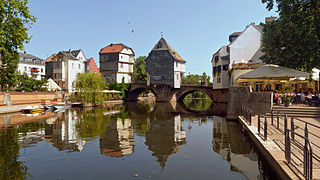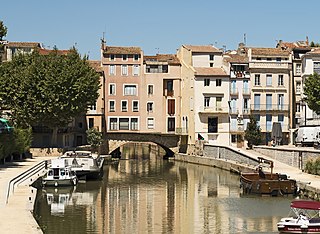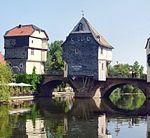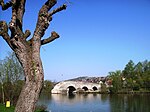
Erfurt (German pronunciation:[ˈɛʁfʊʁt] ) is the capital and largest city of the Central German state of Thuringia, with a population of around 216,000. It lies in the wide valley of the River Gera, in the southern part of the Thuringian Basin, north of the Thuringian Forest, and in the middle of a line of the six largest Thuringian cities, stretching from Eisenach in the west, via Gotha, Erfurt, Weimar and Jena, to Gera in the east. Together with Kassel and Göttingen, it is one of the cities with more than 100,000 inhabitants lying closest to the geographic centre of Germany. Erfurt is 100 km (62 mi) south-west of Leipzig, 250 km (155 mi) north-east of Frankfurt, 300 km (186 mi) south-west of Berlin and 400 km (249 mi) north of Munich.
Bad Kreuznach is a district in Rhineland-Palatinate, Germany. It is bounded by the districts of Rhein-Hunsrück, Mainz-Bingen, Alzey-Worms, Donnersbergkreis, Kusel and Birkenfeld.

Bad Kreuznach is a town in the Bad Kreuznach district in Rhineland-Palatinate, Germany. It is a spa town, most well known for its medieval bridge dating from around 1300, the Alte Nahebrücke, which is one of the few remaining bridges in the world with buildings on it.

The Nahe is a river in Rhineland-Palatinate and Saarland, Germany, a left tributary to the Rhine. It has also given name to the wine region Nahe situated around it.

Norheim is an Ortsgemeinde – a municipality belonging to a Verbandsgemeinde, a kind of collective municipality – in the Bad Kreuznach district in Rhineland-Palatinate, Germany. It belongs to the Verbandsgemeinde of Rüdesheim, whose seat is in the like-named town. Norheim is a state-recognized tourism community (Fremdenverkehrsort). and a winegrowing village.

Oberhausen an der Nahe is an Ortsgemeinde – a municipality belonging to a Verbandsgemeinde, a kind of collective municipality – in the Bad Kreuznach district in Rhineland-Palatinate, Germany. It belongs to the Verbandsgemeinde of Rüdesheim, whose seat is in the like-named town. Oberhausen is a winegrowing village. Oberhausen an der Nahe is one of two municipalities in the district with the name Oberhausen. The other is Oberhausen bei Kirn.

Dalberg is an Ortsgemeinde – a municipality belonging to a Verbandsgemeinde, a kind of collective municipality – in the Bad Kreuznach district in Rhineland-Palatinate, Germany. It belongs to the Verbandsgemeinde of Rüdesheim, whose seat is in the municipality of Rüdesheim an der Nahe.

The Krämerbrücke is a medieval arch bridge in the city of Erfurt, in Thuringia, central Germany, which is lined with half-timbered shops and houses on both sides of a cobblestone street. It is one of the few remaining bridges in the world that have inhabited buildings. It has been continuously inhabited for over 500 years, longer than any other bridge in Europe. The stone, pedestrian bridge, which dates from 1325, is one of the oldest secular structures in Erfurt. It spans the Breitstrom, a branch of Gera River, and connects two town squares – Benediktsplatz and Wenigemarkt.

The County of Sponheim was an independent territory in the Holy Roman Empire that lasted from the 11th century until the early 19th century. The name comes from the municipality of Sponheim, where the counts had their original residence.

The Pont des Marchands is a historic bridge in Narbonne, southern France. It serves as a foundation for a row of houses and shops underneath which the Canal de la Robine runs through the old town. Its segmental arch has a span of ca. 15 m. In Roman times the structure featured as many as six arches.

Wolfgang Bötsch was a German politician, representative of the Christian Social Union in Bavaria (CSU). Between 1974 and 1976 he represented the Landtag of Bavaria. From 1976 to 2005 he was a member of the Bundestag, and between 1993 and 1997 he was the last Minister of Post and Telecommunications. Bötsch died on 14 October 2017 at the age of 79.

Bad Kreuznach station is the largest station in the town of Bad Kreuznach in the German state of Rhineland-Palatinate. The station is classified by Deutsche Bahn as a category 3 station. It is regularly served by Regional-Express and Regionalbahn services on the Nahe Valley Railway (Nahetalbahn). The station is located south-east of the town centre.

The Gau Algesheim–Bad Kreuznach railway is a twin-track, non-electrified main line railway in the German state of Rhineland-Palatinate. It connects Gau-Algesheim on the Left Rhine line with Bad Kreuznach on the Nahe Valley Railway (Nahetalbahn) and is thus part of a regionally important transport corridor between the two state capitals cities of Mainz and Saarbrücken in the Saarland.

Bad Münster am Stein station is a station at a railway junction in Bad Münster am Stein-Ebernburg, a district of Bad Kreuznach in the German state of Rhineland-Palatinate. The station building, dating from about 1910, is protected as a monument. It is classified by Deutsche Bahn as a category 4 station. The station is located in the network of the Rhein-Nahe-Nahverkehrsverbund and belongs to fare zone 401. Its address is: Berliner Straße 20.
Simon II of Sponheim was a German nobleman. He was a member of the House of Sponheim and a ruling Count of the County of Sponheim.

Julia Klöckner is a German politician of the Christian Democratic Union (CDU) who served as Federal Minister of Food, Agriculture and Consumer Protection in the government of Chancellor Angela Merkel from 2018 to 2021. Since 2012, she has also been part of the CDU leadership.
Winnweiler station is the station of the town of Winnweiler in the German state of Rhineland-Palatinate. Deutsche Bahn classifies it as a category 6 station and it has two platforms.

The Alte Nahebrücke is a medieval stone arch bridge in Bad Kreuznach, in western Germany, dating from around 1300, that originally spanned the Nahe river and a neighbouring canal called the Mühlenteich. Only the section spanning the canal remains intact. With four houses on its piers, it is one of the few remaining bridges in the world that has buildings on it.

Fritz Rudolf Körper is a German politician and member of the Social Democratic Party of Germany (SPD). He was a member of the German Bundestag from 1990 to 2013, parliamentary state secretary to the Federal Minister of the Interior from 1998 to 2005 and Deputy Chairman of the SPD parliamentary group from 2005 to 2009.











































